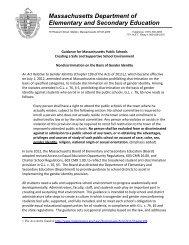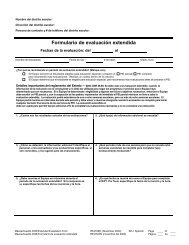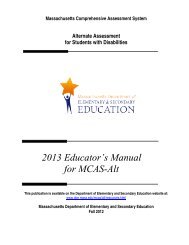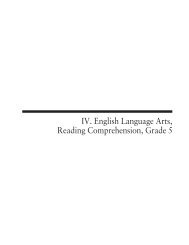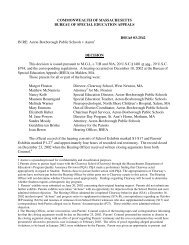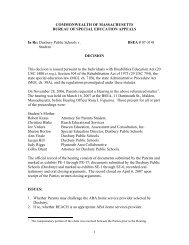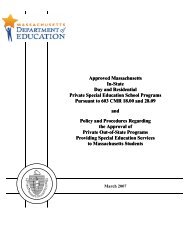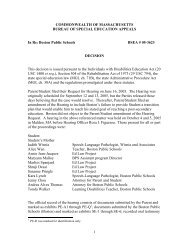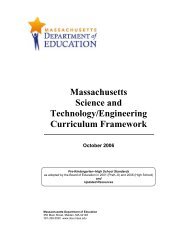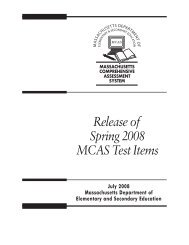Two Year Follow-up Review for Matthew J. Kuss Middle School
Two Year Follow-up Review for Matthew J. Kuss Middle School
Two Year Follow-up Review for Matthew J. Kuss Middle School
Create successful ePaper yourself
Turn your PDF publications into a flip-book with our unique Google optimized e-Paper software.
<strong>Follow</strong>-<strong>up</strong> <strong>Review</strong> Report, Spring 03 <strong>Kuss</strong> <strong>Middle</strong> <strong>School</strong>, Fall River, MA page 8<br />
Table 3: Longitudinal Tracking of Terra Nova Ranks (Normal Curve Equivalent) *<br />
Grade 6 (’00) Grade 7 (’01) Grade 8 (’02)<br />
Reading 37.8 47.4 45.9<br />
Language 42.9 47.4 45.3<br />
Mathematics 42.9 45.3 42.8<br />
The rank of <strong>Kuss</strong> students as indicated by NCE percentiles suggests that students enter the<br />
school per<strong>for</strong>ming about ten percentiles below the national norm (50 th percentile). As students<br />
progress through the school to eighth grade, their national rank improves somewhat at seventh<br />
grade, then declines slightly at eight grade, varying only slightly from their initial per<strong>for</strong>mance.<br />
<strong>Kuss</strong> students maintain and slightly improve their attainment when compared with a nationallynormed<br />
population.<br />
Table 4: Distribution of Terra Nova Per<strong>for</strong>mance Levels , 2001 – 2002, Percent Failing<br />
Percent Failing Grade 6 (01) to Grade 7 (02) Grade 7 (01) to Grade 8 (02)<br />
Reading 85% 64% 73% 53%<br />
Language 83% 74% 82% 54%<br />
Mathematics 94% 76% 83% 65%<br />
The three years of Terra Nova data allow longitudinal tracking of student per<strong>for</strong>mance over time,<br />
and the reduction in the percentage scoring in the failing classification is additional evidence that<br />
students display improved per<strong>for</strong>mance during their time at <strong>Kuss</strong>. For the two years <strong>for</strong> which<br />
data was available to the visiting team, 2000-2001 and 2001–2002, significantly fewer students<br />
fell into the lowest classification. Over the one-year timeframe, 20 percent fewer students were<br />
in the failing category in reading. Ten percent fewer seventh graders and almost 30 percent fewer<br />
eighth graders were failing in language, and just less than 20 percent fewer failed the math<br />
sections of the test after one year at <strong>Kuss</strong>. When examined in this <strong>for</strong>mat, <strong>Kuss</strong> students<br />
demonstrate improvement in per<strong>for</strong>mance level even though national comparisons remain<br />
relatively stable.<br />
The only significant subgro<strong>up</strong> of students at <strong>Kuss</strong> <strong>for</strong> whom achievement data is available is the<br />
special education population. As mentioned in the opening profile section of the report, <strong>Kuss</strong><br />
Special Education students per<strong>for</strong>m comparably to their district counterparts, but dramatically<br />
below the per<strong>for</strong>mance of Special Education students in the state (see Table 2). Terra Nova<br />
scores are not reported to the school separately <strong>for</strong> Special Education students, so the Panel was<br />
unable to assess the per<strong>for</strong>mance of Special Education students on that norm-referenced tool.<br />
For Regular Education students, the area of greatest improvement over the course of the previous<br />
two years has been in MCAS English Language Arts. The <strong>Kuss</strong> grade 7 results show 23 percent<br />
more students reaching the Needs Improvement and Proficient categories in 2002 than in 2001,<br />
and a corresponding 22 percent fewer falling into the Warning category.<br />
* Normal Curve Equivalent (NCE) is a standard score (a score that is expressed as a deviation from a population mean) with the lowest score<br />
being 1, the highest being 99 and the mean (arithmetical average) of 50. NCEs may be added, subtracted and averaged and may be used to<br />
represent how a student or gro<strong>up</strong> of students per<strong>for</strong>med in comparison to the mean. For example, a drop in scores over time means the students<br />
are being passed by their peers nationwide and an increase in scores over time means that students are passing their peers nationwide.<br />
Massachusetts Department of Education




